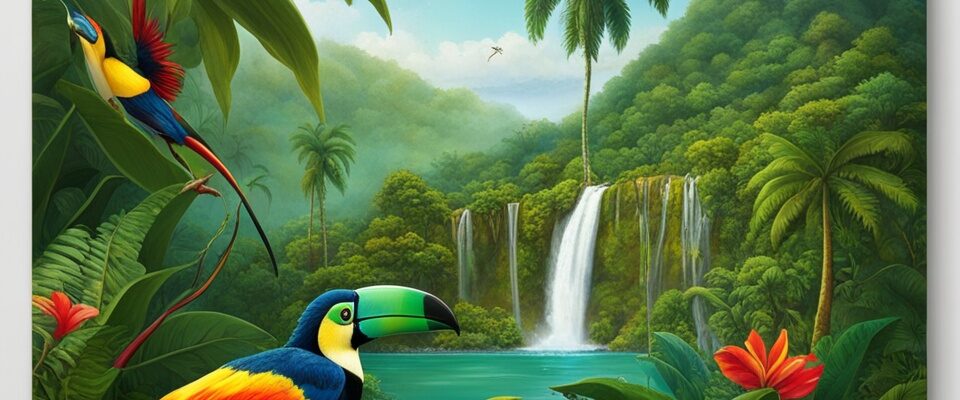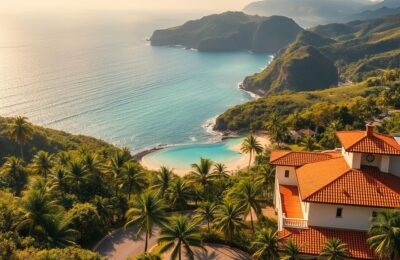Costa Rica Wildlife: Discover Nature’s Marvels
Welcome to Costa Rica, known for its amazing biodiversity and remarkable wildlife. It’s home to over 500,000 species, making it one of the most diverse places on earth. Here, you can see sloths, monkeys, jaguars, and toucans in their natural habitats. A special feature of Costa Rica is its location between North and South America. This gives it a unique mix of plants and animals.
Its national parks and conservation efforts work hard to protect these treasures. So, when you visit Costa Rica, you’re stepping into a real-life nature museum.
But what about the untold stories of Costa Rica’s tropical wildlife and rainforests? How does the country keep its endangered species safe? Let’s dive into these questions and explore the wonders of Costa Rica’s eco-tourism spots.
Key Takeaways
- Costa Rica is home to over 500,000 species, making it one of the most biodiverse countries in the world.
- The country’s strategic position as a biological corridor between North and South America has endowed it with a rich ecological tapestry.
- Costa Rica’s national parks and nature reserves play a crucial role in protecting the country’s endangered species and preserving its biodiversity.
- Visitors can immerse themselves in Costa Rica’s wildlife and rainforests, encountering a living museum of nature’s marvels.
- Eco-tourism and sustainable tourism practices are deeply ingrained in Costa Rica’s approach to safeguarding its natural heritage.
Embrace Costa Rica’s Unparalleled Biodiversity
Costa Rica is like a living museum full of plants and animals. Its landscapes are thick with forests and dotted with mountains. This country is a special place that helps connect wildlife from North and South America.
This connection makes Costa Rica rich in different kinds of life. It has more kinds of plants and animals than some entire continents.
Conservation Efforts: Preserving Natural Habitats
Costa Rica is working hard to keep its nature safe. It has many national parks and reserves to protect its wild places. Efforts like saving Corcovado National Park and the Monteverde Cloud Forest help many species stay safe.
Costa Rica’s Geographical Gift: A Biological Corridor
Being between North and South America, Costa Rica mixes their wildlife. Over 5% of Earth’s plants and animals live here. This makes it a top spot for those who love nature and want to see diverse wildlife.
Enchanting Costa Rica Rainforest Animals
Embark on a journey through the lush costa rica rainforest. Discover the rich tapestry of rainforest animals here. In the emerald canopies are captivating sloths and monkeys.
…each with a charm that draws visitors globally. The presence of jaguars and pumas reminds us of powerful predators in the ecosystem.
Sloths and Monkeys: Charismatic Canopy Dwellers
Sloths and monkeys shine in the costa rica rainforest. They capture hearts with their endearing behaviors.
These rainforest animals thrive in the lush canopy. They showcase their amazing ability to move through branches and leaves.
From sloths’ slow movements to monkeys’ playful games, these animals show the vibrant life in the forest.
Stealthy Predators: Jaguars and Pumas in the Shadows
Jaguars and pumas roam the undergrowth. They are key to keeping the balance of the ecosystem.
These rainforest animals move silently. Often, we don’t see them. They show how every species in the rainforest is essential for its health and strength.
Vibrant Avian Life: Toucans, Macaws, and Quetzals
The vibrant avian life soars and perches across costa rica. It creates a stunning mural of landscapes.
Toucans, macaws, and elusive quetzals enchant birdwatchers and wildlife lovers. They show the amazing biodiversity of the area.
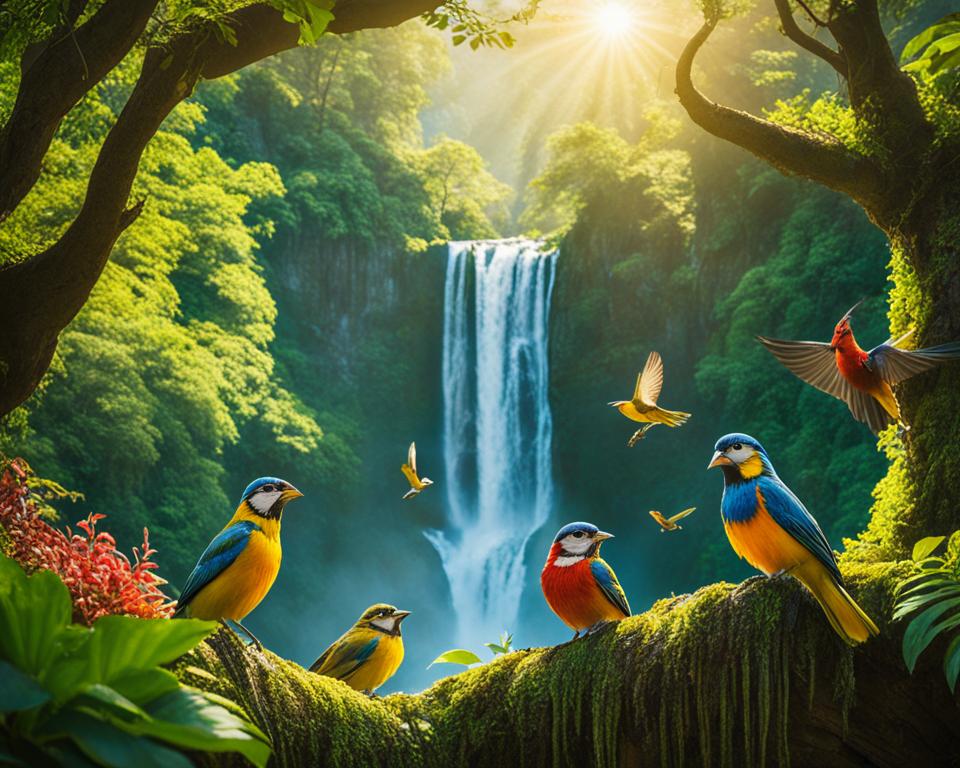
costa-rica-wildlife: Exploring Marine Wonders
Costa Rica is famous for its rich marine life. It’s just as amazing as its famous land animals. The shores by the Pacific and the Caribbean seas are home to many sea creatures. This includes sea turtles, symbols of the oceans’ ancient past. They find safety and nesting spots on beaches like Playa Grande and Cahuita National Park. Here, visitors can watch sea turtles in the thousands come ashore, known as arribada, to nest.
Sea Turtles in Costa Rica: Ancient Mariners Nesting
In Costa Rica, leatherback turtles lay their eggs at Playa Grande, Las Baulas National Marine Park, from October to March. Then, hawksbill turtles do the same at Cahuita National Park from May to October. These turtles are in great danger, which makes protecting them crucial.
Humpback Whales: Majestic Migrations
Costa Rica’s warm ocean waters are perfect for humpback whales. They arrive yearly to breed and give birth. You can see them in Ballena National Marine Park from August to April. Luckily, they are doing well, not at risk.
Whale Sharks: Gentle Giants of the Ocean
Not forgetting the whale sharks. They too show why we must protect Costa Rica’s oceans. These enormous but peaceful creatures are in the Pacific all year. Sadly, they are endangered, underscoring the need to safeguard their habitats.
The Pacific side of Costa Rica is home to around 7,000 sea creatures. This represents 3.5% of Earth’s marine biodiversity. There could be hundreds of thousands more creatures yet to be discovered. All these, from turtles to whales, offer unique chances to see amazing wildlife.
The Microcosm of Costa Rican Tropical Animals
We move our eyes from the top of the trees to the ground, where a special world exists in Costa Rica. Here, a wide variety of animals live, like the famous red-eyed tree frog and many kinds of butterflies. Each species adds to the beauty and life of this special place.
The Iconic Red-Eyed Tree Frog: A Rainforest Jewel
The red-eyed tree frog is a unique creature with its vivid green body, bright red eyes, and orange feet. It is a special kind of frog that is only found in Costa Rica. These frogs mainly come out at night. Their colorful eyes help them scare away their enemies and run off quickly.
Rainforest Butterflies: Fluttering Colors of Costa Rica
The rainforests in Costa Rica are like a paradise for butterflies, hosting over 1,251 different types. Each butterfly adds its own color to the air, painting the environment with life. The blue Morpho butterfly is especially stunning as it flies gracefully, moving like a brief, beautiful moment. These small, vibrant animals are essential for keeping the tropical environment healthy. They show why it’s vital to protect the many species in Costa Rica.
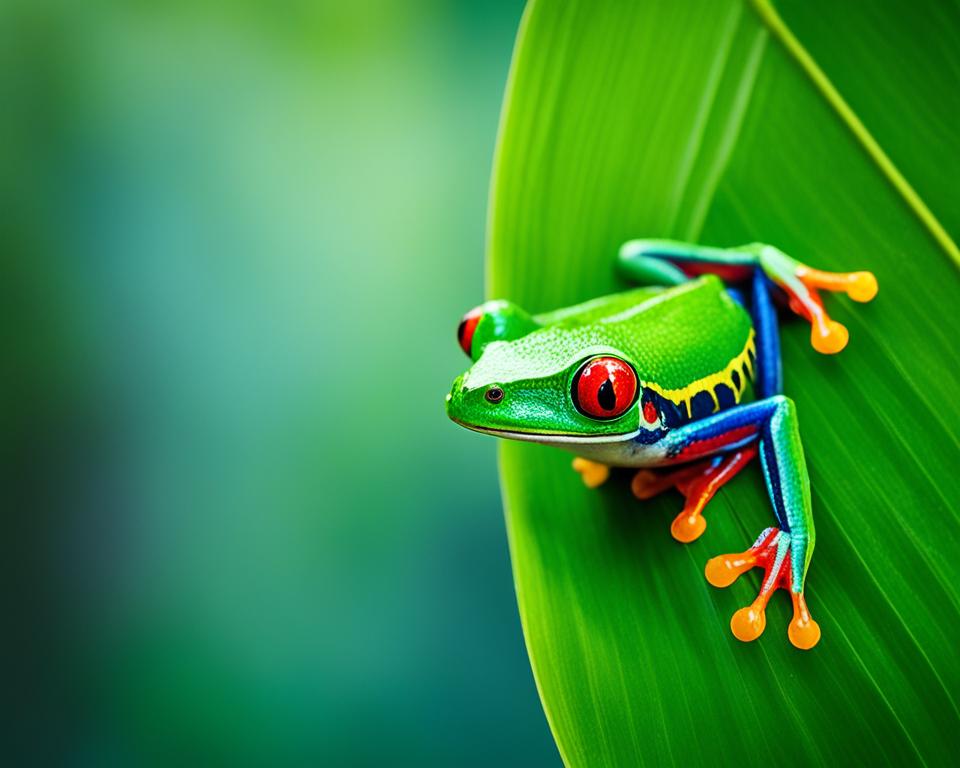
Marino Ballena National Park: The Whale Tail Phenomenon
The Marino Ballena National Park is in Costa Rica, on its southern Pacific shore. Known for the “Whale Tail,” a unique sandbar shaped like a whale’s tail, it’s a wonder to behold. At low tide, the ocean uncovers this stunning form. The sandbank emerges, created by the meeting currents loaded with sand from rocks and coral. This beautiful sight has become a favorite among visitors.
The park is vital for wildlife, serving as a key path in the Eastern Pacific. It’s home to the longest humpback whale migration season globally. From December to April and July to November, humpback whales visit. They come to have their babies and enjoy the warm, sheltered waters. The park also boasts rich rainforests where you can see creatures like howler monkeys, sloths, and the brilliant Scarlet Macaw.
| Statistic | Value |
|---|---|
| Park Size | 110 hectares of land and 5,373 hectares of ocean |
| Whale Watching Seasons | 2 seasons (December-April and July-November) |
| Entrance Fees | $6 USD for foreigners, ₡1,000 for nationals, free for children under 2 |
| Coastline Length | 15 km |
| Travel Time from San José | 3-4 hours, depending on traffic |
| Prohibited Activities | Alcoholic beverages and camping (nearby Chamán beach allowed) |
| Park Size | 270 protected land acres and 13,200 acres of preserved ocean |
Birdwatching Haven: Costa Rica’s Avian Diversity
Costa Rica is filled with colorful birds, making it a top spot for birdwatching. The quetzal is one special bird here. It’s hard to find, living in the misty cloud forests.
Quetzals: The Elusive Jewel of the Cloud Forests
The resplendent quetzal is bright and has a long, beautiful tail. It’s the national bird of Costa Rica. On birdwatching tours in places like Corcovado National Park, you can see these birds and many others.
Birding Hotspots and Nature Reserves
Costa Rica is known for saving its birds and is a great place for birdwatching. The Papagayo Peninsula has over 250 bird types. There are many places like Palo Verde National Park and Carara National Park where you can see birds and explore nature.
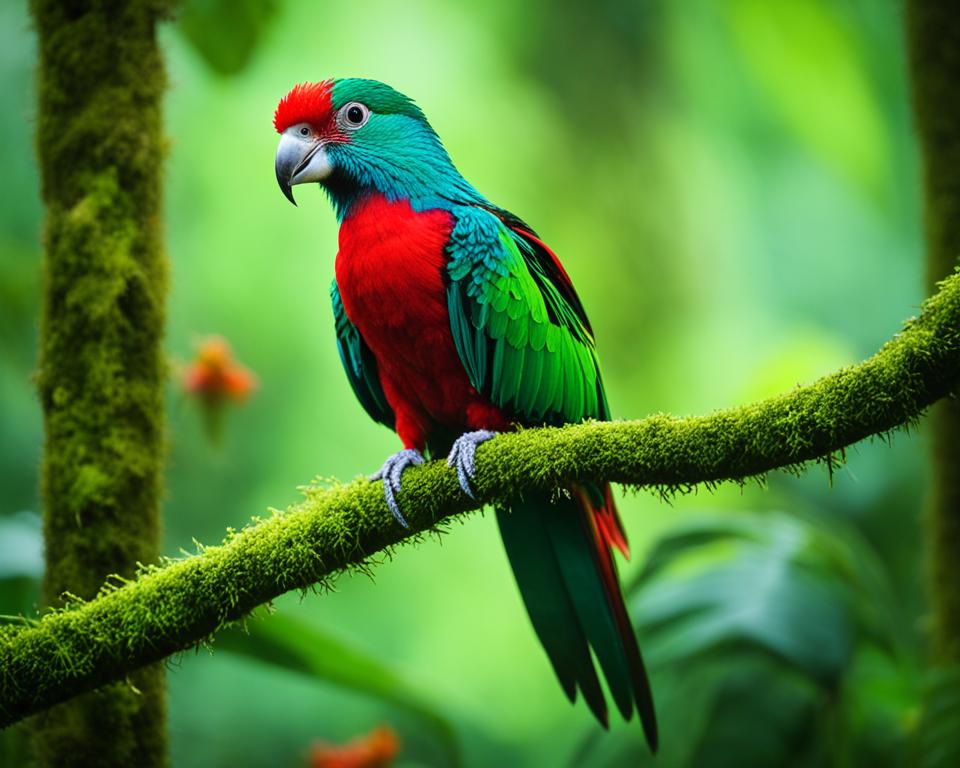
Adventure in the Costa Rican Wilderness
Costa Rica is full of adventure for those who love nature. Its hiking and trekking trails are perfect for exploring. You can walk through the rainforests and cloud forests. There, you will see plants and animals that are unique to the area.
Hiking and Trekking Trails
If you’re up for more, try whitewater rafting and kayaking. These activities let you ride the rivers and enjoy beautiful views. You’ll not only have fun but also learn about eco-tourism. And, how people here are protecting the natural wilderness.
Whitewater Rafting and Kayaking
For a high view, try canopy tours and zip-lining. You’ll glide above the trees. This way, you’ll see how the forest lives together. It gives you a special look at the country’s nature.
Canopy Tours and Zip-Lining
These adventures help you connect with nature. They show why Costa Rica’s natural places are important to protect. It’s all about enjoying nature while keeping it safe for the future.
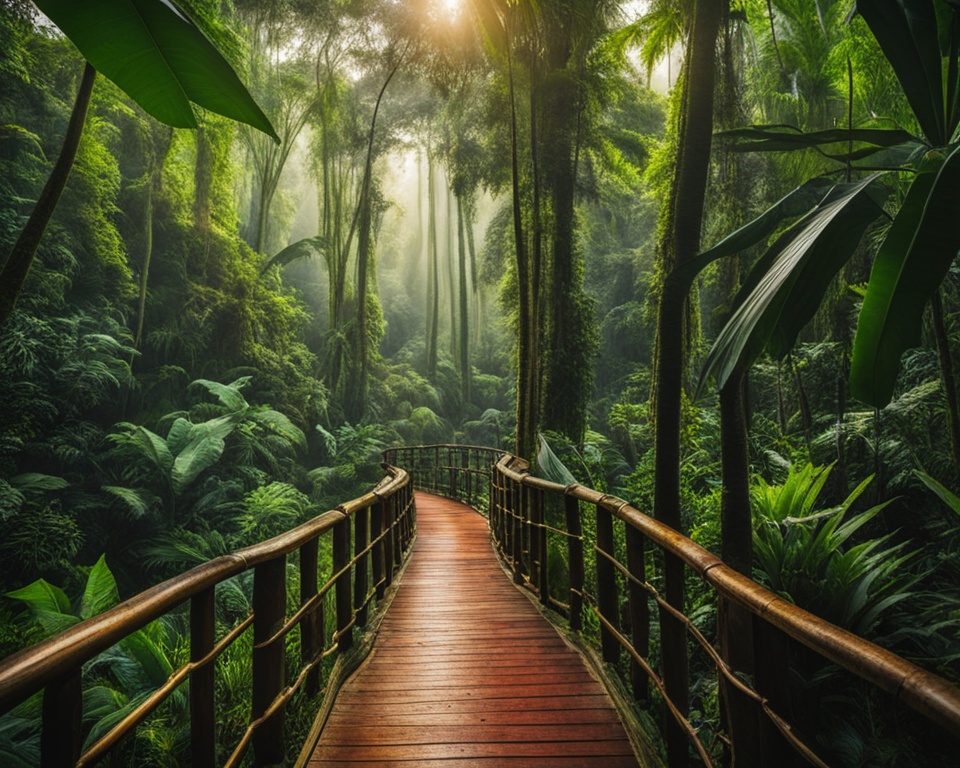
Eco-Tourism and Sustainable Travel
Costa Rica is a top spot for eco-tourism and sustainable travel. It lets visitors enjoy its natural beauty without harming it. The country focuses on green ways to travel, reduce waste, and protect wildlife. These are key parts of its tourism.
Community-Based Tourism Initiatives
Local communities in Costa Rica get help from tourism that’s based on them. Travelers learn about the local culture and efforts to protect nature. This way, people from outside and locals connect, and Costa Rica’s eco-tourism grows.
Eco-Lodges and Sustainable Accommodations
There are special places to stay that care about nature and use green energy. These lodges are a lovely way to be close to nature. They are also leading the way in protecting Costa Rica’s plants and animals. These places show how to travel and protect nature at the same time.
Costa Rica is a model for taking care of the planet while people enjoy visiting. Its choices now will help the planet later.
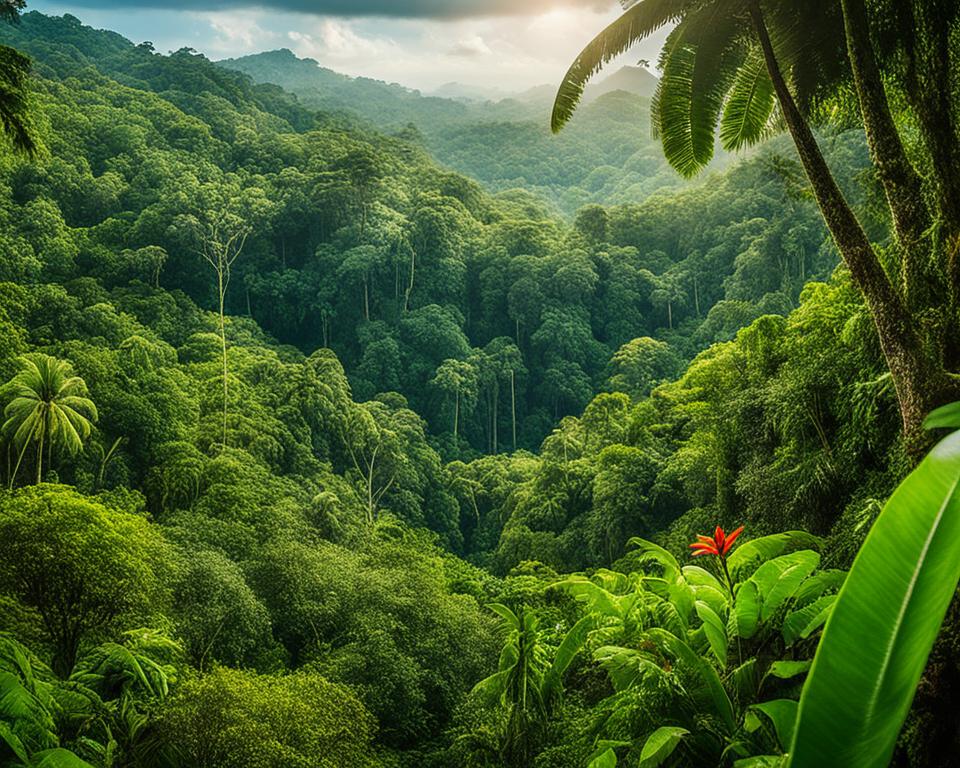
The Wonders of Costa Rican National Parks
Costa Rica’s national parks are the country’s most prized places for conservation and eco-tourism. The Corcovado National Park stands out, known as the “crown jewel.” It is rich in plant and animal life. Here, you can find jaguars, tapirs, and the rare harpy eagle.
Corcovado National Park: A Biodiversity Hotspot
Corcovado National Park covers 103,000 hectares and holds Costa Rica’s amazing biodiversity. It is the home for over 500 tree species, 6,000 kinds of insects, and many mammals like jaguars and tapirs. The park also includes the hard-to-spot harpy eagle.
Monteverde Cloud Forest Reserve: A Misty Oasis
The Monteverde Cloud Forest Reserve sits in central Costa Rica’s mountaintops. It’s known for its ethereal cloud forests. Here is the perfect place for bird lovers, with quetzals and over 400 bird species making their home here.
Manuel Antonio National Park: Rainforest Meets Beach
The Manuel Antonio National Park is on Costa Rica’s Pacific coast. Its mix of rainforests and white sandy beaches is breathtaking. This park is full of wildlife, including the lively white-faced capuchin monkeys and sloths up in the trees.
Costa Rica’s national parks are vital for ecology research and biodiversity conservation. They are living places with lots of animals and plants. Thanks to efforts in conservation and eco-tourism, Costa Rica protects its stunning natural world for future generations.
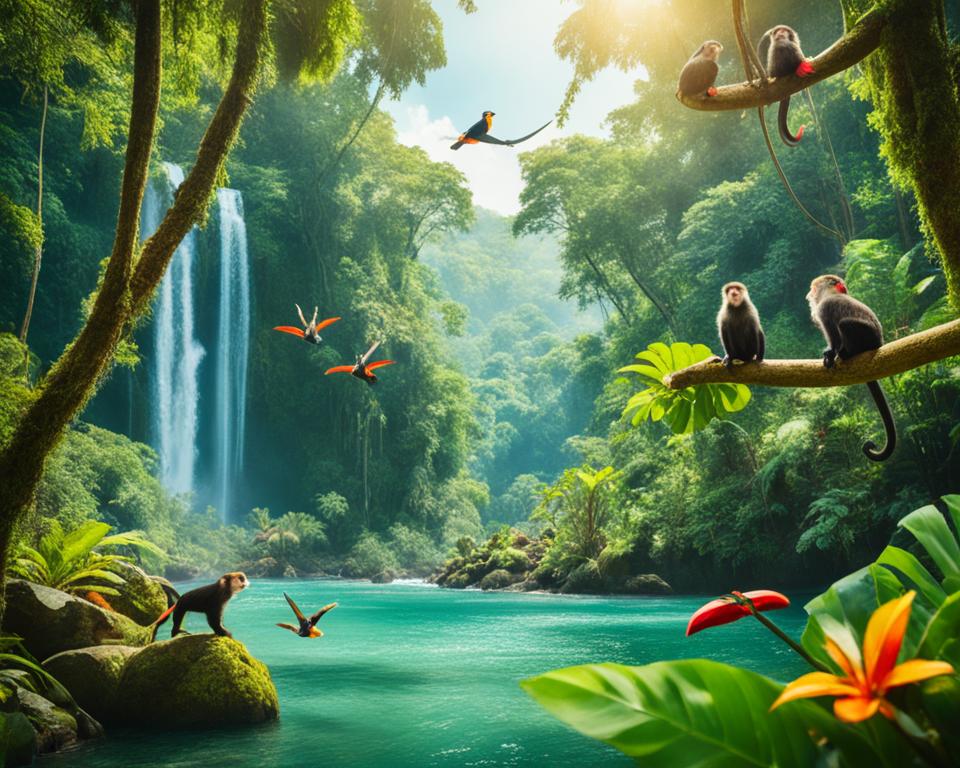
Jungle Encounters: Costa Rica’s Exotic Mammals
Exploring Costa Rica’s thick jungles often leads to seeing its unique exotic mammals. The country’s star attractions include sloths. Seen in nature, they slowly move and charm everyone with their lovable looks.
Sloths: Nature’s Slowest Creatures
Costa Rica’s sloths are world-famous. They come in two types, two-toed and three-toed. Their slow, cute ways are why people come to the jungles to watch them.
Howler Monkeys: The Boisterous Jungle Dwellers
Then there are the loud howler monkeys. Their calls can be heard from far away. They, along with big cats like jaguars, show Costa Rica’s wild side. This exposure aids in realizing the need for eco-tourism and conservation.
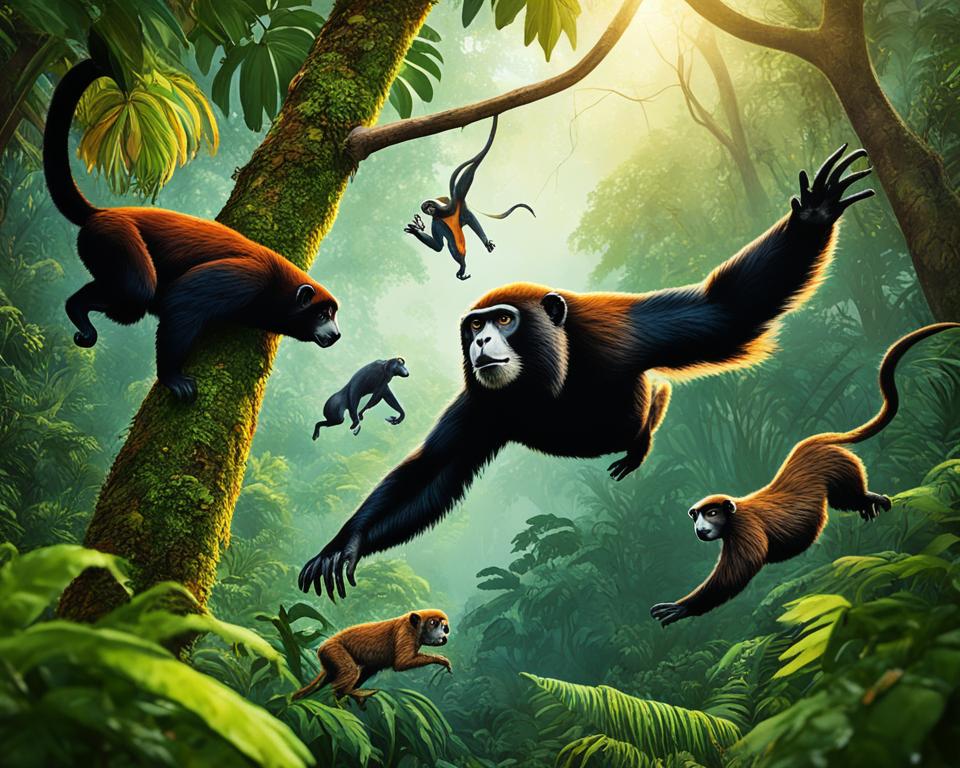
Preserving Costa Rica’s Natural Heritage
Costa Rica is at the forefront of saving the environment. It spends a lot to keep its natural sites safe. Places like Corcovado National Park and Tortuguero National Park act as homes for many plants and animals. They protect these living spaces. This effort helps keep Costa Rica’s wide range of life going strong.
Conservation Efforts and Protected Areas
The country didn’t just stop at setting up these conservation areas. It also turned to sustainable tourism and eco-friendly initiatives. They help the locals and protect the earth. Efforts range from backing eco-friendly places to using more green energy. Costa Rica leads the way in being earth-friendly. It shows how much it wants to keep its natural marvels for the future.
Sustainable Tourism and Eco-Friendly Initiatives
Costa Rica’s many national parks and spots it looks after, along with its vow for green tourism and eco efforts, lay clear its constant love for its biodiversity and preserving wildlife. This full-on effort makes sure Costa Rica’s natural gift stays strong. It provides a neat chance for everyone to see and value this gorgeous place.
Wildlife Photography in Costa Rica
Costa Rica is a top spot for people who love nature and wildlife photography. It’s filled with rich wildlife and stunning views. To take great photos, you need both skill and respect for the environment.
Tips for Capturing Nature’s Beauty
If you want to get better at wildlife photography, there are some tips. Make sure you have the right gear. Always keep your distance from animals and be aware of their natural behavior. Plus, using ethical photography principles helps protect the places and creatures you photograph.
Ethical Photography Guidelines
It’s important to take photos that are considerate of nature. By using sustainable photography techniques, you help keep Costa Rica’s beauty safe for future generations to enjoy.
Best Locations for Wildlife Photography
National parks like Corcovado and the Osa Peninsula are paradise for wildlife photography. They’re home to a vast array of animals, from slow-moving sloths to agile jungle cats. These areas are perfect for capturing Costa Rica’s biodiversity.
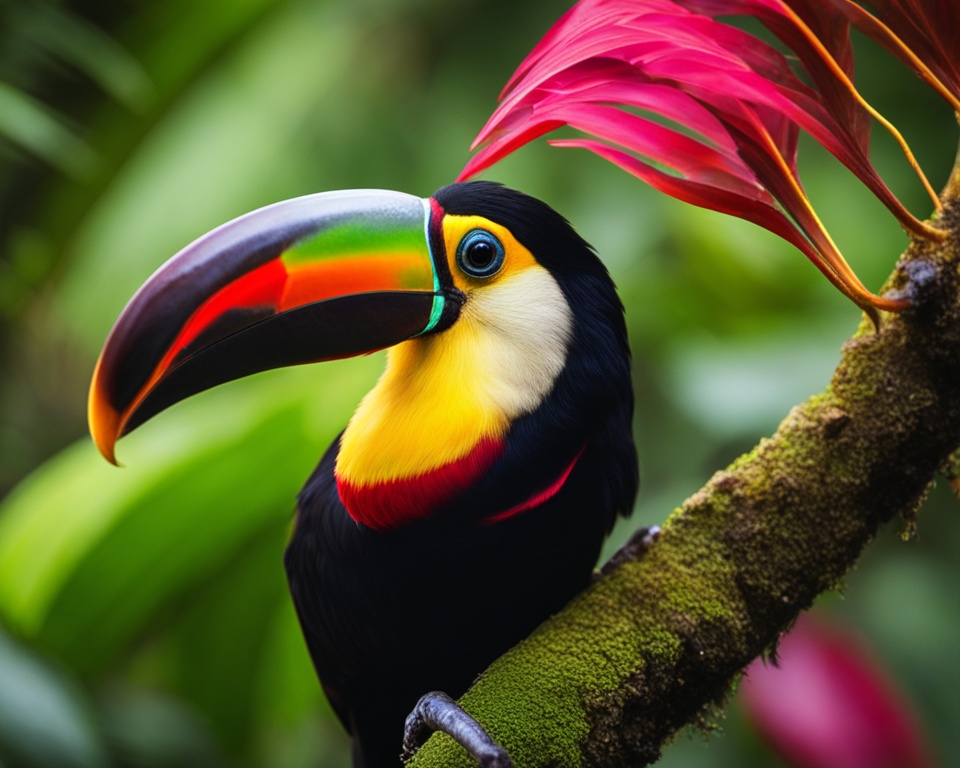
Night Encounters: Costa Rica’s Nocturnal Wildlife
As the sun hides in Costa Rica, a different world wakes up. You can see the secret lives of the country’s nocturnal wildlife. From the bright eyes of the red-eyed tree frog to the quiet jaguars, night brings lots of action.
Special Guided night tours let people like you dive into the dark world. You get to see how everything is connected in Costa Rica’s nature. It’s a chance to learn more about the animals that usually stay hidden at night.
On these night tours, you can also enjoy the clear night sky with no city lights getting in the way. It’s perfect for bird fans to watch rare night birds. Don’t worry, experts will guide you, and you’ll have the right tools to explore safely.
FAQ
What makes Costa Rica a biodiversity hotspot?
How does Costa Rica protect its natural heritage?
What are some of the iconic animals found in Costa Rica’s rainforests?
What makes Costa Rica’s marine life so remarkable?
What are some of the unique tropical animals found in Costa Rica?
What is the unique feature of Marino Ballena National Park?
Why is Costa Rica a premier destination for birdwatching?
What adventure activities can visitors enjoy in Costa Rica’s wilderness?
How does Costa Rica promote eco-tourism and sustainable travel?
What are some of the notable national parks in Costa Rica?
What are some of the captivating mammals found in Costa Rica’s jungles?
How does Costa Rica demonstrate its commitment to environmental conservation?
What tips can help visitors capture the beauty of Costa Rica’s wildlife through photography?
What can visitors expect to see when exploring Costa Rica’s nocturnal wildlife?
Source Links
- https://crie.cr/what-wild-animals-live-in-costa-rica/
- https://www.kimkim.com/c/costa-rica-wildlife-and-nature-14-days
- https://www.gviusa.com/blog/smb-costa-ricas-biodiversity-a-journey-through-its-forests/
- https://tamaluxury.com/interesting-facts-about-costa-rica/
- https://enchanting-costarica.com/tours-and-experiences/8-tips-spot-costa-rica-rainforest-wildlife/
- https://crie.cr/costa-rica-wildlife-guide-common-animals-birds/
- https://www.visitcostarica.com/
- https://criacademy.com/costa-rica-marine-life-4-types-of-underwater-wonders/
- https://internationalliving.com/countries/costa-rica/manuel-antonio-costa-rica/
- https://www.allworld.com/wildlife-in-costa-rica/
- https://www.kimkim.com/c/costa-rica-wildlife-tour-12-days
- https://www.costaricadiveandsurf.com/marino-ballena-national-park/
- https://www.twoweeksincostarica.com/whale-tail-uvitas-marino-ballena-national-park/
- https://www.costaricafocus.com/birding-papagayo-peninsula-costa-rica-a-complete-guide/
- https://www.findmycostarica.com/blog/bird-watching-costa-rica/
- https://crie.cr/how-many-different-birds-are-in-costa-rica/
- https://costaricaexperts.com/things-to-do/wildlife/
- https://www.kimkim.com/c/costa-rica-luxury-wildlife-and-adventure-sports-getaway-11-days
- https://www.gaprealestate.com/about-us/
- https://www.visitcostarica.com/en/costa-rica/things-to-do/ecoturism
- https://www.gondwanaecotours.com/travel-journal/ecotourism-in-costa-rica/
- https://www.gaprealestate.com/list-my-property/
- https://entercostarica.com/travel-guide/popular-activities/wildlife-observation
- https://journeycostarica.com/blog/how-costa-ricas-national-parks-protect-happiness
- https://costaricaexperts.com/things-to-do/national-parks/
- https://www.paradisecatchers.com/costa-rica-wildlife/
- https://www.gaprealestate.com/understanding-open-listings-in-real-estate-in-costa-rica/
- https://ylangylangbeachresort.com/ecotourism-in-costa-rica/
- http://costarica-embassy.org/index.php?q=node/12
- https://www.gaprealestate.com/differences-between-open-and-exclusive-listings-in-real-estate/
- http://costaricabirdingtours.com/costa-rica-photo-tour-bird-and-wildlife-photography-tour.html
- https://www.wildimages-phototours.com/photography-tours/costa-rica-wildlife-photography-tour/
- https://www.findmycostarica.com/experience/night-walk/
- https://crie.cr/costa-rica-night-tours/

